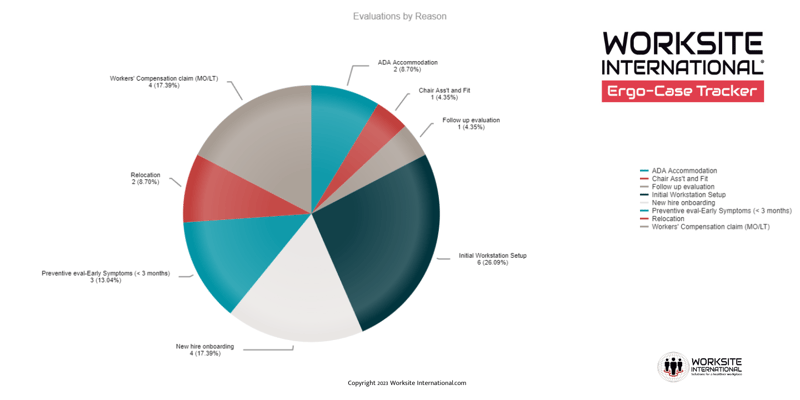
In our fast-paced world, technology intertwines seamlessly with our daily lives. The significance of ergonomics and its impact on worker well-being has never been more pronounced.
As we strive for efficiency and productivity at work, the spotlight turns to the science of ergonomics' critical role in human-centered design to optimize our workspaces and daily routines. But how do you know your ergonomics process is measuring up and making a difference?
What is Your Compass?
Imagine embarking on a journey without a map or setting sail without a compass. Similarly, implementing ergonomic changes without a robust tracking system is akin to navigating uncharted waters. It's a voyage into the unknown, where the destination is uncertain, and the success of the endeavor remains ambiguous.
W. Edwards Deming is often quoted as saying, "You can't manage what you can't measure."
Whoever is responsible for buying ergonomics services in your company should have a thorough understanding of the depth and breadth of ergonomics needed for the organization. Their knowledge and experience with ergonomics, along with leadership, will influence whether they value investing in ergonomics, how much should be allocated, and where.
Only by tracking the associated key performance indicators (KPIs) of your ergonomics process and your employees’ ergonomics journey will the answers become clear. Like a compass, your ergonomics process data will steer you toward your desired destination of enhanced well-being, increased productivity, and sustainable success. After all, if you don’t measure what you are doing, then how do you know how you are doing or if you are doing it well?
The Six Tenets of a Participatory Ergonomics Process:
At Worksite International Inc., our research and experience demonstrate the best outcomes when organizations implement a participatory ergonomics process based on these six tenets.
1. Communication
2. Employee Participation
3. Ergonomic Evaluations
4. Solution Implementation
5. Accountability & Follow-through
6. Track and Measure Outcomes
Measure So You Can Manage
Having the means to track your ergonomic evaluation process is vital to how you manage it. Following the six tenets of a participatory ergonomics process will keep your organization from falling short of having an ineffective ergonomics process. This includes tracking and measuring leading and lagging indicators.Just as a ship captain scans the horizon for impending storms so they can change direction, leading indicators in ergonomics act as proactive tools, foreseeing challenges and guiding informed decisions before issues arise. These indicators are early proactive signals of ergonomic success, focusing on ongoing processes and conditions and offering insights into the effectiveness of your ergonomic strategies.
Examples of KPIs include timely scheduling of assessments, reasons why evaluations were needed, employee training participation, tracking pre- and post-risk scores, monitoring timely receipt of purchases, and many more indicators demonstrating emerging patterns of whether to change course before you experience losses.
On the other hand, lagging indicators are retrospective measures akin to observing a ship's wake and assessing the impact of decisions already made. In ergonomics, these indicators, such as injury rates, costs, and absenteeism, reflect historical outcomes. In many cases, these lagging indicators may have converted from a once early proactive sign and are a critical measure of the quality of your program.
While crucial for assessing overall success, lagging indicators lack the immediacy and proactive nature of leading indicators, which are far more predictive of your success.
Introducing the Ergo-Case Tracker
In my past role as the Ergonomics Manager for a large county agency, I needed to track all the evaluation requests to keep organized. In doing so, I realized the valuable data presented in the process and how I could use it as a predictive tool to manage and reduce risk. Measuring and monitoring the results of our ergonomics process in Excel showed me I needed a better way!
Fast forward ten years, and my experience has led to the creation of cloud-based software designed specifically for the Ergonomics Process Leader to utilize a time and money-saving ergonomic case management tracker of essential KPIs to measure your ergonomics process success.
The Worksite International Ergo-Case Tracker is the perfect ergonomics process management solution designed for small and midsize corporate professionals responsible for ergonomics like EHS Managers, Ergo Team leaders, Ergo Specialists, HR, and Risk Managers.
Our software rides on the backbone of the six tenets of the Worksite International Ergonomics Process, a proven strategy by creating an ergo-case tracker that can:
- Monitor evaluation progress in real-time
- Track the entire employee ergonomics journey.
- Provide timely reports of organization and department ergonomic process results.
- Measure your return on investment.
- Show leadership how much your program is really saving while improving employee wellbeing.
- And much more!
Tired of tracking on spreadsheets and smart sheets? Need a better way to manage your ergo evaluation requests? Get ready for a game-changing cloud-based solution that streamlines your ergonomics process management. Click below to learn more.


Comments